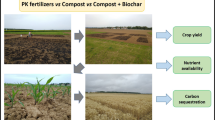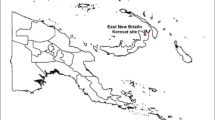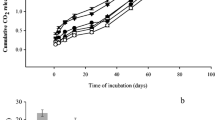Abstract
Brazil has the world’s largest cattle herd and is the largest beef exporter, although the degradation of 70% of its pastures cause environmental damage and reduced yields. However, pasture recovery is carried out with expensive mineral fertilizers, whose effects do not last and can cause soil acidification and nutrient loss. Environmentally friendly alternatives are compost and biochar, which can increase nutrient use efficiency through higher soil retention and slower availability, but they lack application recommendations. Therefore, it is necessary to provide helpful information to improve grass yield and replace or reduce the use of mineral fertilizers. For this, a mineral fertilized experiment and another not fertilized were developed to evaluate the dry shoot mass of Marandu palisade grass and some soil chemical attributes after applying compost, biochar, oxidized or not, and their mixtures. Mineral fertilization increased grass productivity, which was further increased when compost, biochar, and mixtures were applied. The combinations more often provided the best results of the variables than the individual application of compost or biochar. In most cases, the best mixture contained 0.25% compost and 0.75% oxidized biochar, but the application of 0.5% of each is promising. This study’s leading information for cattle breeders indicates biochar and compost mixtures that improve soil fertility and grass yield, together with mineral fertilization. However, it is necessary to study biochar oxidation and the enrichment of the compost and biochar with nutrients.




Similar content being viewed by others
Data availability
The study is based on original data that can be made available to the publisher.
References
Agegnehu G, Bass A et al (2015) Biochar and biochar-compost as soil amendments: effects on peanut yield, soil properties and greenhouse gas emissions in tropical North Queensland, Australia. Agric Ecosyst Environ 213:72–85. https://doi.org/10.1016/j.agee.2015.07.027
Agegnehu G, Bass AM, Nelson PN, Bird MI (2016) Benefits of biochar, compost and biochar–compost for soil quality, maize yield and greenhouse gas emissions in a tropical agricultural soil. Sci Total Environ 543:295–306. https://doi.org/10.1016/j.scitotenv.2015.11.054
Akhtar SS, Andersen NM, Liu F (2015) Residual effects of biochar on improving growth, physiology and yield of wheat under salt stress. Agr Water Manag 158:61–68. https://doi.org/10.1016/j.agwat.2015.04.010
Alburquerque JA, Salazar P et al (2013) Enhanced wheat yield by biochar addition under different mineral fertilization levels. Agron Sustain Dev 33:475–484. https://doi.org/10.1007/s13593-012-0128-3
Amlinger F, Peyr S et al. (2007) Beneficial effects of compost application on fertility and productivity of soils. Federal Ministry for Agriculture and Forestry, Environment and Water Management, Viena. https://www.umweltnet.at/filemanager/download/20558/. Accessed 26 June 2021
Bass AM, Bird MI, Kay G, Muirhead B (2016) Soil properties, greenhouse gas emissions and crop yield under compost, biochar and co-composted biochar in two tropical agronomic systems. Sci Total Environ 550:459–470. https://doi.org/10.1016/j.scitotenv.2016.01.143
Bezerra MGS, Silva GGC et al (2017) Cassava wastewater as organic fertilizer in ‘Marandu’ grass pasture. R Bras Eng Agríc Ambient 21:404–409. https://doi.org/10.1590/1807-1929/agriambi.v21n6p404-409
Borchard N, Ladd B et al (2014) Black carbon and soil properties at historical charcoal production sites in Germany. Geoderma 232–234:236–242. https://doi.org/10.1016/j.geoderma.2014.05.007
Carvalho MTM, Madari BE et al (2013) Biochar improves soil fertility of a clay soil in the Brazilian Savannah: short term effects and impact on rice yield. J Agric Rural Dev Trop Subtrop 114:101–107
Delevatti LM, Cardoso AS et al (2019) Effect of nitrogen application rate on yield, forage quality, and animal performance in a tropical pasture. Sci Rep 9:7596. https://doi.org/10.1038/s41598-019-44138-x
Ding Y, Liu Y, Liu S et al (2016) Biochar to improve soil fertility. A Review Agron Sustain Dev 36:36. https://doi.org/10.1007/s13593-016-0372-z
Domingues RR, Sánchez-Monedero MA et al (2020) Enhancing cation exchange capacity of weathered soils using biochar: feedstock, pyrolysis conditions and addition rate. Agronomy 10:824. https://doi.org/10.3390/agronomy10060824
Ferreira DF (2014) Sisvar: a guide for its bootstrap procedures in multiple comparisons. Ciênc Agrotec 38:109–112. https://doi.org/10.1590/S1413-70542014000200001
Fischer D, Glaser B (2012) Synergisms between compost and biochar for sustainable soil amelioration. In: Kumar S, Bharti A Management of organic waste. InTech, Rijeka, pp. 167–198. https://www.intechopen.com/chapters/27163. Accessed 05 May 2021
Glaser B, Wiedner K, Seelig S, Schmidt HP, Gerber H (2015) Biochar organic fertilizers from natural resources as substitute for mineral fertilizers. Agron Sustain Dev 35:667–678. https://doi.org/10.1007/s13593-014-0251-4
Gomes LSP, Braz TGS et al (2018) Níveis de substituição de ureia por esterco bovino na adubação de capim-marandu. Rev Ciênc Agrár 41:914–923. https://doi.org/10.19084/RCA17272
Guarda VDA, Guarda RDA (2014) Brazilian tropical grassland ecosystems: distribution and research advances. Am J Plant Sci 5:924–932. https://doi.org/10.4236/ajps.2014.57105
Hagemann N, Kammann CI, Schmidt HP, Kappler A, Behrens S (2017) Nitrate capture and slow release in biochar amended compost and soil. PLoS ONE 12:e0171214. https://doi.org/10.1371/journal.pone.0171214
Hale SE, Nurida NL et al (2020) The effect of biochar, lime and ash on maize yield in a long-term field trial in a Ultisol in the humid tropics. Sci Total Environ 719:137455. https://doi.org/10.1016/j.scitotenv.2020.137455
Huang D, Wang Y et al (2016) Influence of morphological and chemical features of biochar on hydrogen peroxide activation: implications on sulfamethazine degradation. RSC Adv 6:73186–73196. https://doi.org/10.1039/c6ra11850j
Huff MD, Lee JW (2016) Biochar-surface oxygenation with hydrogen peroxide. J Environ Manage 165:17–21. https://doi.org/10.1016/j.jenvman.2015.08.046
Jank L, Barrios SC, Do Valle CB, Simeao RM, Alves GF (2014) The value of improved pastures to Brazilian beef production. Crop Pasture Sci 65:1132–1137. https://doi.org/10.1071/CP13319
Jeffery S, Verheijen FGA, Van Der Velde M, Bastos AC (2011) A quantitative review of the effects of biochar application to soils on crop productivity using meta-analysis. Agric Ecosyst Environ 144:175–187. https://doi.org/10.1016/j.agee.2011.08.015
Jindo K, Suto K et al (2012) Chemical and biochemical characterisation of biochar-blended composts prepared from poultry manure. Bioresour Technol 110:396–404. https://doi.org/10.1016/j.biortech.2012.01.120
Joseph S, Kammann CI et al (2018) Microstructural and associated chemical changes during the composting of a high temperature biochar: mechanisms for nitrate, phosphate and other nutrient retention and release. Sci Total Environ 618:1210–1223. https://doi.org/10.1016/j.scitotenv.2017.09.200
Kavitha B, Reddy PVL et al (2018) Benefits and limitations of biochar amendment in agricultural soils: a review. J Environ Manage 227:146–154. https://doi.org/10.1016/j.jenvman.2018.08.082
Latawiec AE, Strassburg BBN et al (2019) Biochar amendment improves degraded pasturelands in Brazil: environmental and cost-benefit analysis. Sci Rep 9:11993. https://doi.org/10.1038/s41598-019-47647-x
Liu J, Schulz H et al (2012) Short-term effect of biochar and compost on soil fertility and water status of a Dystric Cambisol in NE Germany under field conditions. J Plant Nutr Soil Sci 175:698–707. https://doi.org/10.1002/jpln.201100172
Luo X, Liu G et al (2017) Use of biochar-compost to improve properties and productivity of the degraded coastal soil in the Yellow River Delta, China. J Soils Sediments 17:780–789. https://doi.org/10.1007/s11368-016-1361-1
Madari BE, Costa AR et al. (2006) Carvão vegetal como condicionador de solo para arroz de terras altas (cultivar Primavera): um estudo prospectivo. Embrapa Arroz e Feijão, Santo Antônio de Goiás, Brazil. https://ainfo.cnptia.embrapa.br/digital/bitstream/CNPAF/25441/1/comt_125.pdf. Accessed 15 July 2021
Mia S, Dijkstra FA, Singh B (2017) Long-term aging of biochar: a molecular understanding with agricultural and environmental implications. Adv Agron 141:1–51. https://doi.org/10.1016/bs.agron.2016.10.001
Morales MM, Comerford N, Guerrini IA, Falcão NPS, Reeves JB (2013) Sorption and desorption of phosphate on biochar and biochar–soil mixtures. Soil Use Manage 29:306–314. https://doi.org/10.1111/sum.12047
Novotny EH, Maia CMBF, Carvalho MTM, Madari BE (2015) Biochar: pyrogenic carbon for agricultural use – a critical review. Rev Bras Cienc Solo 39:321–344. https://doi.org/10.1590/01000683rbcs20140818
Oldfield TL, Sikirica N et al (2018) Biochar, compost and biochar-compost blend as options to recover nutrients and sequester carbon. J Environ Manage 218:465–476. https://doi.org/10.1016/j.jenvman.2018.04.061
Oliveira Junior JC, Chiapini M et al (2017) Genesis and classification of sodic soils in the northern Pantanal. Rev Bras Cienc Solo 41:e0170015. https://doi.org/10.1590/18069657rbcs201
Orrico Junior MAP, Silveira AP et al (2018) Use of organic compost for the fertilization of piatã and paiaguás grasses: effects of dose on morphogenetic, structural, nutritional, and productive characteristics. Compost Sci Util 26:201–208. https://doi.org/10.1080/1065657X.2018.1457998
Petter FA, Madari BE et al (2012) Soil fertility and upland rice yield after biochar application in the Cerrado. Pesqui Agropecu Bras 47:699–706. https://doi.org/10.1590/S0100-204X2012000500010
Pimenta AS, Miranda NO, Carvalho MAB, Silva GGC, Oliveira EMM (2019) Effects of biochar addition on chemical properties of a sandy soil from northeast Brazil. Arab J Geosci 12:70. https://doi.org/10.1007/s12517-018-4194-y
Rafael RBA, Fernández-Marcos ML et al (2019) Benefits of biochar and NPK fertilizers for soil quality and growth of cowpea (Vigna unguiculata L. Walp.) in an acid arenosol. Pedosphere 29:311–333. https://doi.org/10.1016/s1002-0160(19)60805-2
Rezende EIP, Angelo LC, Santos SS, Mangrich AS (2011) Biocarvão (biochar) e sequestro de carbono. Rev Virtual Quim 3:426–433. https://doi.org/10.5935/1984-6835.20110046
Ribeiro Júnior MR, Canaver AB, Rodrigues AB, DominguesNeto FJ, Spers RC (2015) Desenvolvimento de brachiaria brizantha cv, marandú submetidas a diferentes tipos de adubação (química e orgânica). Rev Unimar Cienc 24:49–53
Ribelatto PJC, Genú AM, Lustosa SBC, Pott CA (2019) Atributos químicos do solo e produção de Urochloa brizantha cv. Marandu. Investig Agrar 21:108–116. https://doi.org/10.18004/investig.agrar.2019.diciembre.108-116
Sahin MB, Taskin EC et al (2017) Effect of acid modification of biochar on nutrient availability and maize growth in a calcareous soil. Soil Use Manage 33:447–456. https://doi.org/10.1111/sum.12360
Santos HG, Jacomine PKT et al (2018) Brazilian Soil Classification System. Embrapa Solos, Rio de Janeiro
Schmidt HP, Pandit B et al (2015) Fourfold increase in pumpkin yield in response to low-dosage root zone application of urine-enhanced biochar to a fertile tropical soil. Agriculture 5:723–741. https://doi.org/10.3390/agriculture5030723
Schulz H, Glaser B (2012) Effects of biochar compared to organic and inorganic fertilizers on soil quality and plant growth in a greenhouse experiment. J Plant Nutr Soil Sci 175:410–422. https://doi.org/10.1002/jpln.201100143
Silva FC (2009) Manual de análises químicas de solos, plantas e fertilizantes. Embrapa Informação Tecnológica, Brasília
Šimanský V, Aydın E, Horák J (2022) Is it possible to control the nutrient regime of soils with different texture through biochar substrates? Agronomy 12:51. https://doi.org/10.3390/agronomy12010051
Sizmur T, Quilliam R et al (2015) Application of biochar for soil remediation. In: Guo M, He Z (eds) Uchimiya SM Agricultural and Environmental Applications of Biochar: Advances and Barriers. Soil Science Society of America, Madison, pp 295–324. https://doi.org/10.2136/sssaspecpub63.2014.0046.5
Soil Survey Staff (2014) Keys to Soil Taxonomy, 12th edn. USDA-Natural Resources Conservation Service, Washington, DC
Steiner C, Teixeira WG et al (2007) Long term effects of manure, charcoal and mineral fertilization on crop production and fertility on a highly weathered Central Amazonian upland soil. Plant Soil 291:275–290. https://doi.org/10.1007/s11104-007-9193-9
Stentiford E, Sánchez‐Monedero MA (2016) Past, present and future of composting research. Acta Hortic 1146. https://doi.org/10.17660/ActaHortic.2016.1146.1
Teixeira PC, Donagemma GK, Fontana A, Teixeira WG (2017) Manual de métodos de análise de solo. 3th. ed. Embrapa, Brasília, DF
Tian D, Niu S (2015) A global analysis of soil acidification caused by nitrogen addition. Environ Res Lett 10:024019. https://doi.org/10.1088/1748-9326/10/2/024019
Thomas BN, George SC (2015) Production of activated carbon from natural sources. Trends Green Chem 1:7. https://doi.org/10.21767/2471-9889.100007
Tkaczyk P, Mocek-Płóciniak A et al (2020) The mineral fertilizer-dependent chemical parameters of soil acidification under field conditions. Sustainability 12:7165. https://doi.org/10.3390/su12177165
Trompowsky PM, Benites VM et al (2005) Characterization of humic like substances obtained by chemical oxidation of eucalyptus charcoal. Org Geochem 36:1480–1489. https://doi.org/10.1016/j.orggeochem.2005.08.001
Van Zwieten L, Kimber S et al (2010) Effects of biochar from slow pyrolysis of papermill waste on agronomic performance and soil fertility. Plant Soil 327:235–246. https://doi.org/10.1007/s11104-009-0050-x
Vandecasteele B, Sinicco T, D’Hose T, Vanden Nest T, Mondini C (2016) Biochar amendment before or after composting affects compost quality and N losses, but not P plant uptake. J Environ Manage 168:200–209. https://doi.org/10.1016/j.jenvman.2015.11.045
Verheijen FGA, Jeffery S, Bastos AC, Van derWelde M, Diafas I (2010) Biochar application to soils - a critical scientific review of effects on soil properties, processes and functions. EUR 24099 EN, European Commission, Luxembourg. https://publications.jrc.ec.europa.eu/repository/handle/JRC55799. Acessed 29 january 2019
Wang Y, Ghimire S, Wang J, Dong R, Li Q (2021) Alternative management systems of beef cattle manure for reducing nitrogen loadings: a case-study approach. Animals 11:574. https://doi.org/10.3390/ani11020574
Wang C, Luo D, Zhang X, Huang R et al (2022) Biochar-based slow-release of fertilizers for sustainable agriculture: A mini review. Environ Sci Ecotechnol 10:100167. https://doi.org/10.1016/j.ese.2022.100167
Wong MTF, Nortcliff S, Swift RS (1998) Method for determining the acid ameliorating capacity of plant residue compost, urban waste compost, farmyard manure, and peat applied to tropical soils. Commun Soil Sci Plant Anal 29:2927–2937. https://doi.org/10.1080/00103629809370166
Acknowledgements
This study was made possible by the Annual Teacher Qualification and Training Plan (PQD) of Universidade Federal Rural do Semiárido (UFERSA) concerning Neyton de Oliveira Miranda. We are grateful to Professor Gualter Guenter Costa da Silva for providing the compost and the late Professor Emerson Moreira de Aguiar for giving access to the Multiuser Laboratory of Animal Nutrition at UFRN.
Funding
This study was supported by research funds from the Agricultural School of Jundiaí, Academic Unit of Agricultural Sciences, Federal University of Rio Grande do Norte, and the Center for Agrarian Sciences of the Federal University of the Semiarid Region.
Author information
Authors and Affiliations
Contributions
All authors whose names appear on the submission made substantial contributions to the conception or design of the work; or the acquisition, analysis, or interpretation of data; or drafted the work or revised it critically for important intellectual content; or approved the version to be published; and agree to be accountable for all aspects of the work.
Corresponding author
Ethics declarations
Ethics approval
Not applicable.
Consent to participate
Not applicable.
Conflict of interest
The authors declare that they have no competing interests.
Additional information
Responsible Editor: Stefan Grab
Rights and permissions
Springer Nature or its licensor (e.g. a society or other partner) holds exclusive rights to this article under a publishing agreement with the author(s) or other rightsholder(s); author self-archiving of the accepted manuscript version of this article is solely governed by the terms of such publishing agreement and applicable law.
About this article
Cite this article
da Silva, I.E., Pimenta, A.S., de Lacerda, C.F. et al. Biochar, compost, and their mixtures influence the dry mass of the shoot of Marandu palisade grass and soil nutritional status. Arab J Geosci 16, 185 (2023). https://doi.org/10.1007/s12517-023-11261-z
Received:
Accepted:
Published:
DOI: https://doi.org/10.1007/s12517-023-11261-z




